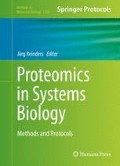Abstract
In quantitative proteomics, large lists of identified and quantified proteins are used to answer biological questions in a systemic approach. However, working with such extensive datasets can be challenging, especially when complex experimental designs are involved. Here, we demonstrate how to post-process large quantitative datasets, detect proteins of interest, and annotate the data with biological knowledge. The protocol presented can be achieved without advanced computational knowledge thanks to the user-friendly Perseus interface (available from the MaxQuant website, www.maxquant.org). Various visualization techniques facilitating the interpretation of quantitative results in complex biological systems are also highlighted.
Access this chapter
Tax calculation will be finalised at checkout
Purchases are for personal use only
References
Aebersold R, Mann M (2003) Mass spectrometry-based proteomics. Nature 422:198–207
Olsen JV, Mann M (2013) Status of large-scale analysis of post-translational modifications by mass spectrometry. Mol Cell Proteomics 12:3444–3452
Altelaar AF, Munoz J, Heck AJ (2013) Next-generation proteomics: towards an integrative view of proteome dynamics. Nat Rev Genet 14:35–48
Vaudel M, Sickmann A, Martens L (2010) Peptide and protein quantification: a map of the minefield. Proteomics 10:650–670
Bantscheff M, Lemeer S, Savitski MM et al (2012) Quantitative mass spectrometry in proteomics: critical review update from 2007 to the present. Anal Bioanal Chem 404:939–965
Bantscheff M, Schirle M, Sweetman G et al (2007) Quantitative mass spectrometry in proteomics: a critical review. Anal Bioanal Chem 389:1017–1031
Vaudel M, Sickmann A, Martens L (2014) Introduction to opportunities and pitfalls in functional mass spectrometry based proteomics. Biochim Biophys Acta 1844:12–20
Aasebo E, Vaudel M, Mjaavatten O et al (2014) Performance of super-SILAC based quantitative proteomics for comparison of different acute myeloid leukemia (AML) cell lines. Proteomics 14:1971–1976
Cox J, Mann M (2008) MaxQuant enables high peptide identification rates, individualized p.p.b.-range mass accuracies and proteome-wide protein quantification. Nat Biotechnol 26:1367–1372
Vizcaino JA, Deutsch EW, Wang R et al (2014) ProteomeXchange provides globally coordinated proteomics data submission and dissemination. Nat Biotechnol 32:223–226
Martens L, Hermjakob H, Jones P et al (2005) PRIDE: the proteomics identifications database. Proteomics 5:3537–3545
Kohlbacher O, Reinert K, Gropl C et al (2007) TOPP—the OpenMS proteomics pipeline. Bioinformatics 23:e191–e197
Bertsch A, Gropl C, Reinert K et al (2011) OpenMS and TOPP: open source software for LC-MS data analysis. Methods Mol Biol 696:353–367
Deutsch EW, Mendoza L, Shteynberg D et al (2010) A guided tour of the Trans-Proteomic Pipeline. Proteomics 10:1150–1159
Vaudel M, Burkhart JM, Zahedi RP et al (2015) PeptideShaker enables reanalysis of MS-derived proteomics data sets. Nature biotechnology 33:22–24
Cox J, Mann M (2012) 1D and 2D annotation enrichment: a statistical method integrating quantitative proteomics with complementary high-throughput data. BMC Bioinformatics 13(Suppl 16):S12
Acknowledgements
F.S.B. and F.S. acknowledge the support by the Norwegian Cancer Society. H.B. is supported by the Research Council of Norway.
Author information
Authors and Affiliations
Corresponding author
Editor information
Editors and Affiliations
Rights and permissions
Copyright information
© 2016 Springer Science+Business Media New York
About this protocol
Cite this protocol
Aasebø, E., Berven, F.S., Selheim, F., Barsnes, H., Vaudel, M. (2016). Interpretation of Quantitative Shotgun Proteomic Data. In: Reinders, J. (eds) Proteomics in Systems Biology. Methods in Molecular Biology, vol 1394. Humana Press, New York, NY. https://doi.org/10.1007/978-1-4939-3341-9_19
Download citation
DOI: https://doi.org/10.1007/978-1-4939-3341-9_19
Published:
Publisher Name: Humana Press, New York, NY
Print ISBN: 978-1-4939-3339-6
Online ISBN: 978-1-4939-3341-9
eBook Packages: Springer Protocols

